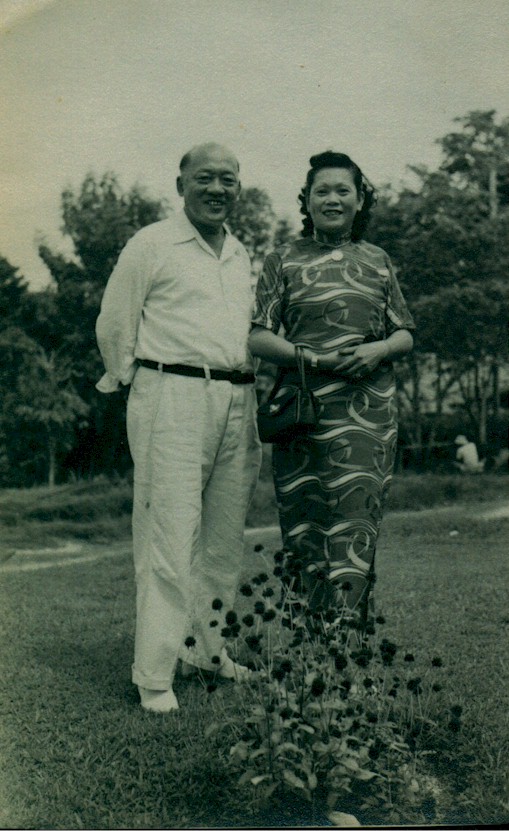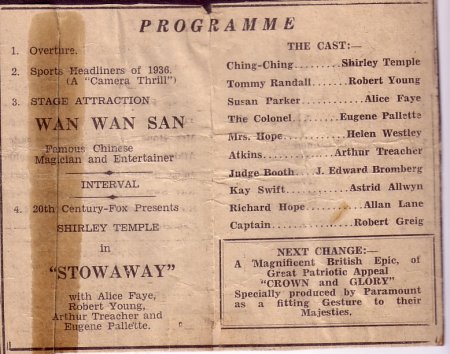


Dad and Mom
![]()
Ed's parents. My father, Wong Tong Quong, was born in 1895 at Deadwood, South Dakota and my mother, Sue Woon Wong, was born in 1911 at Sandakan, State of Sabah, Malaysia. Here are their biographies.
My Mother. My mother did not tell us much of her past and I and my siblings missed the opportunities to ask her while she was alive. In April of 2001 on a trip to Kota Kinabalu, State of Sabah in Malaysia, I with my brothers and sisters found out my mother's background from our cousins on our mother’s side. Apparently, she was an adopted child of a Chinese couple who migrated from Sandakan, Sabah to Hong Kong. Her mother gave her up for adoption after her father and brother passed away; her mother was alone and found it hard to provide for herself and her daughter. My mother was raised by her adopted parents in Hong Kong. How my father met my mother is still a mystery. I can only guess that he met her while he was recruiting for an assistant to help him in his magic show. They were a perfect match, she seemed to like the spotlights as much as he did. She became her assistant in his magic performance. In his magic performance, she would be levitated, saw in half, pierced with swords or disappeared on command.
My Father My father was the youngest son of Fee Lee Wong, a prominent frontier merchant in Deadwood’s Chinatown. He was born in Deadwood, South Dakota in 1895. He attended grammar school for one year before leaving for China in 1902 with the rest of the Wong family. Fee Lee Wong planned the trip to China so that the children would get a better understanding of the Chinese language and Chinese culture. My father and his siblings started Chinese school late and had a difficult time catching up. He stayed in China for 10 years before returning to the United States in 1912 at the age of 17. In Deadwood he faced the same dilemma as he did in China. He found himself in a class with much younger students because he was so far behind in his English. He tried to catch up but found it very disheartening. He quit school after three years to help his father tending the Wing Tsue Emporium store in Deadwood.
Back to China in 1920 My father returned alone to China in 1920 at the age of 25. His parents decided that it was about time for him to settle down. He went through an arranged marriage and brought his wife Mee Lin back to the United States in 1921. Between 1921 to1928 he tried various jobs as salesman, restaurant owner and even as an interpreter for the American President Lines that traveled between Hong Kong and Seattle. He was not very successful nor was he happy in any of these jobs. A daughter Mildred and a son Waldo were born during these years.
He wanted to be a Magician During his travels, he became fascinated with magic. He began by learning a few magic tricks and enjoyed entertaining his friends with his sleight of hand. He enjoyed performing magic and soon gained enough confidence that he felt he could earn a living as a magician. He spent his time and money studying magic tricks. He learned all the illusions of those days and practiced his hand tricks until he could perform them instinctively. He could do all kinds of magic tricks with cards, ropes, handkerchiefs, rings but his specialty was with cigarettes. He could make cigarettes appear or disappear, turn a cigarette into a cigar, pick pack after pack of cigarette from his top hat, push a cigarette in one ear and pull it out of the other ear or pop it out of the cigarette holder.
Wan Wan San, the Magician My father broke into show business by performing as a stage attraction before a feature movie (see the program below). But he was ambitious; he wanted to be the main attraction rather than as a sideshow. So he worked out a plan and returned to China in 1928 with his wife and two children. His second son Mathew was born in 1929. He began recruiting acrobats and a magician assistant to perform with his magic show as the main attraction. In 1930 he left his family in China and returned to the U.S. with a troupe of 14 acrobats and an assistant. He used the stage name of Wan Wan San and his troupe was known as the Wan Wan San Company. From 1930 to 1933, the Wan Wan San Company entertained in theatres all over the East Coast.

Back to China in 1933 As the visas of the troupe were about to expire, my father returned to China with the troupe in 1933. He disbanded the old troupe and began to organize a new troupe of singers, dancers, acrobats, cyclists, musicians and comedians. The new Wan Wan San Company became a vaudeville show and it was carefully geared toward the Asian audiences. He found that it was easier and more profitable for him to make a living as an American magician in Southeast Asia rather than as a Chinese magician in America (see photos below).
|
|
|
|
American Magician |
Chinese Magician |
The Wan Wan San Company For the next two decades, the Wan Wan San Company traveled throughout Southeast Asia performing in cities and towns in the Philippines, Indonesia, Thailand, Burma, Malaysia, Hong Kong and Singapore. My father had as many as 40 performers in his troupe. The highlight of the show was always his magic performance assisted by his second wife Sue Woon. Occasionally, he would have an added attraction such as when he recruited an American cowboy as a sharp shooter in his show. It was a grueling nonstop schedule of performances and constant traveling throughout the year.
Out of the Jungle When the Australian 9th Division landed in nearby Brunei and liberated the area in June 1945, the Japanese occupation was finally over. We came out of hiding and reported our whereabouts to the U.S. Embassy. My parents had lost all their possessions including the tent, all the show props and all our personal properties. Without the fund to organize a vaudeville show or the props to perform in a theatre, my father took the family to Singapore where he earned a living by performing in amusement parks.
|
1946 |
2006 |
|
|
|
| Standing from left to right: Frank, Helen, George, Janice and Tommy. Seating from left to right: Lily, Mom, Anna, Dad and Edward. Not in photo are William, No. 3 son, and youngest daughter Rose | Standing from left to right: George, Rose, Frank and Anna. Seating from left to right: Lily, Tommy, Janice and Edward. Not in photo are William and Helen |
![]()
This page was last updated on March 24, 2007